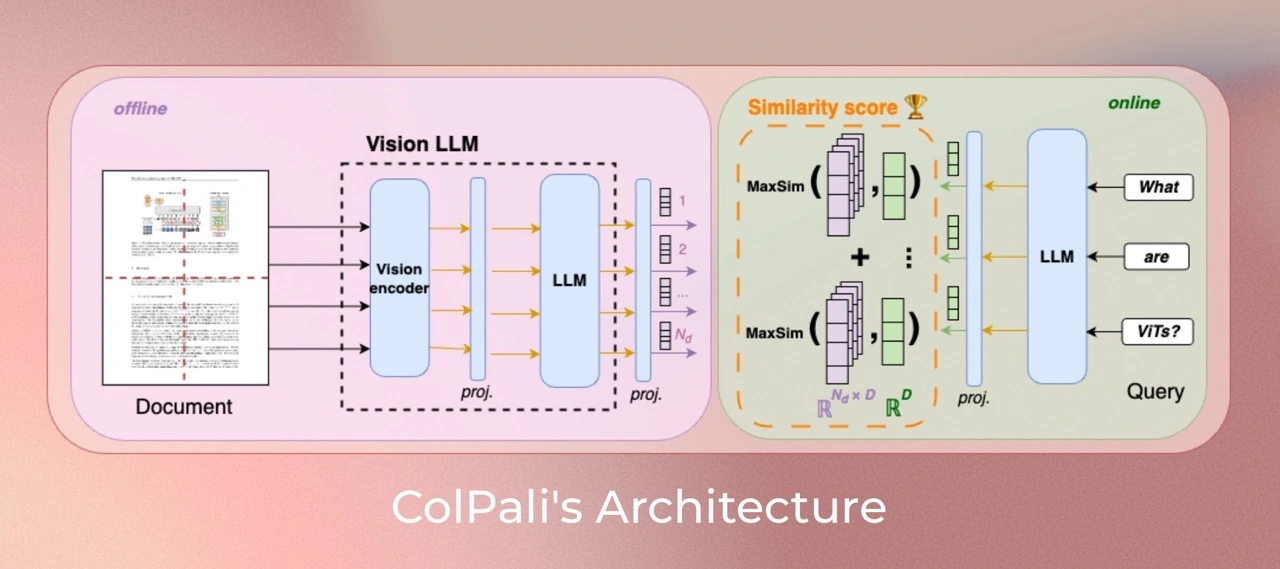🚀 ColQwen2: Visual Retriever based on Qwen2-VL-2B-Instruct with ColBERT strategy
ColQwen2 is a model leveraging a novel architecture and training strategy based on Vision Language Models (VLMs). It can efficiently index documents from their visual features, offering a powerful solution for visual document retrieval.
Key Features

🚀 Quick Start
Prerequisites
Make sure colpali-engine is installed from source or with a version superior to 0.3.4. transformers version must be > 4.46.1.
pip install git+https://github.com/illuin-tech/colpali
Basic Usage
import torch
from PIL import Image
from transformers.utils.import_utils import is_flash_attn_2_available
from colpali_engine.models import ColQwen2, ColQwen2Processor
model = ColQwen2.from_pretrained(
"vidore/colqwen2-v1.0",
torch_dtype=torch.bfloat16,
device_map="cuda:0",
attn_implementation="flash_attention_2" if is_flash_attn_2_available() else None,
).eval()
processor = ColQwen2Processor.from_pretrained("vidore/colqwen2-v1.0")
images = [
Image.new("RGB", (128, 128), color="white"),
Image.new("RGB", (64, 32), color="black"),
]
queries = [
"Is attention really all you need?",
"What is the amount of bananas farmed in Salvador?",
]
batch_images = processor.process_images(images).to(model.device)
batch_queries = processor.process_queries(queries).to(model.device)
with torch.no_grad():
image_embeddings = model(**batch_images)
query_embeddings = model(**batch_queries)
scores = processor.score_multi_vector(query_embeddings, image_embeddings)
✨ Features
- Dynamic Image Resolution: This model takes dynamic image resolutions in input and does not resize them, changing their aspect ratio as in ColPali. The maximal resolution is set so that 768 image patches are created at most. Experiments show clear improvements with larger amounts of image patches, at the cost of memory requirements.
- Trained with Specific Engine: This version is trained with
colpali-engine==0.3.1.
- Same Training Data: Data is the same as the ColPali data described in the paper.
📚 Documentation
Model Training
Dataset
Our training dataset of 127,460 query - page pairs consists of train sets from openly available academic datasets (63%) and a synthetic dataset. The synthetic dataset is made up of pages from web - crawled PDF documents and augmented with VLM - generated (Claude - 3 Sonnet) pseudo - questions (37%). The training set is fully English, allowing us to study zero - shot generalization to non - English languages. We ensure no multi - page PDF document is used in both ViDoRe and the train set to prevent evaluation contamination. A validation set is created with 2% of the samples to tune hyperparameters.
Note: Multilingual data is present in the pretraining corpus of the language model and most probably in the multimodal training.
Parameters
All models are trained for 1 epoch on the train set. Unless specified otherwise, we train models in bfloat16 format, use low - rank adapters (LoRA) with alpha = 32 and r = 32 on the transformer layers from the language model, as well as the final randomly initialized projection layer, and use a paged_adamw_8bit optimizer. We train on an 8 GPU setup with data parallelism, a learning rate of 5e - 5 with linear decay with 2.5% warmup steps, and a batch size of 32.
Version Specificity
This model takes dynamic image resolutions in input and does not resize them, changing their aspect ratio as in ColPali. Maximal resolution is set so that 768 image patches are created at most. Experiments show clear improvements with larger amounts of image patches, at the cost of memory requirements. This version is trained with colpali-engine==0.3.1. Data is the same as the ColPali data described in the paper.
Limitations
- Focus: The model primarily focuses on PDF - type documents and high - resources languages, potentially limiting its generalization to other document types or less represented languages.
- Support: The model relies on multi - vector retreiving derived from the ColBERT late interaction mechanism, which may require engineering efforts to adapt to widely used vector retrieval frameworks that lack native multi - vector support.
📄 License
ColQwen2's vision language backbone model (Qwen2 - VL) is under apache2.0 license. The adapters attached to the model are under MIT license.
📞 Contact
- Manuel Faysse: manuel.faysse@illuin.tech
- Hugues Sibille: hugues.sibille@illuin.tech
- Tony Wu: tony.wu@illuin.tech
📚 Citation
If you use any datasets or models from this organization in your research, please cite the original dataset as follows:
@misc{faysse2024colpaliefficientdocumentretrieval,
title={ColPali: Efficient Document Retrieval with Vision Language Models},
author={Manuel Faysse and Hugues Sibille and Tony Wu and Bilel Omrani and Gautier Viaud and Céline Hudelot and Pierre Colombo},
year={2024},
eprint={2407.01449},
archivePrefix={arXiv},
primaryClass={cs.IR},
url={https://arxiv.org/abs/2407.01449},
}
📋 Model Information
| Property |
Details |
| Model Type |
Visual Retriever based on Qwen2-VL-2B-Instruct with ColBERT strategy |
| Training Data |
A training dataset of 127,460 query - page pairs, composed of 63% openly available academic datasets and 37% synthetic dataset |
| Pipeline Tag |
visual - document - retrieval |
| Base Model |
vidore/colqwen2 - base |
| Library Name |
colpali |
| Tags |
colpali, vidore - experimental, vidore |

 Transformers
Transformers